Baseball statistics play an important role in evaluating the progress of a player or team.

The Neo Geo, stylized as NEO•GEO and also written as NEOGEO, is a ROM cartridge-based arcade system board and fourth generation home video game console released on April 26, 1990, by Japanese game company SNK Corporation. It was the first system in SNK's Neo Geo family.

SNK Corporation is a Japanese video game hardware and software company. It is the successor to the company Shin Nihon Kikaku and presently owns the SNK video game brand and the Neo Geo video game platform, and electronics. SNK's predecessor Shin Nihon Kikaku Corporation was founded in 1978 by Eikichi Kawasaki. In 1981, the name was informally shortened to SNK Corporation, which became the company's official name in 1986.

Blazing Star is a shoot 'em up video game developed by Yumekobo and published by SNK in 1998 for the Neo Geo arcade and home systems. It is a follow-up to Pulstar (1995) and features side-scrolling action similar to its predecessor and different ships with varying characteristics. It was made less challenging than its predecessor, and the graphic quality was improved upon.

Throughout the history of baseball, the rules have frequently changed as the game has continued to evolve. The rules of baseball can vary slightly from league to league, with there being dozens of leagues worldwide. A few common rules most professional leagues have in common is that four balls is a base on balls, three strikes is a strikeout, and three outs end a half-inning. One example of differing rules in professional leagues is the use of a pitch clock, which in Major League Baseball (MLB) is in place to speed up the pace of the game by forcing pitchers to pitch in a 15–20 second window, while in Nippon Professional Baseball (NPB) no such rule exists.

R.B.I. Baseball is a baseball sports video game series. R.B.I. stands for "run batted in". Launched in 1987 as a localized version of Namco's Family Stadium series, the R.B.I. Baseball series initially ran through 1995. In 2014, the series was rebooted as a competitor to MLB: The Show, with releases each year until its cancellation. The series ended in 2022 with the release of MLB The Show 22 on the Nintendo Switch.
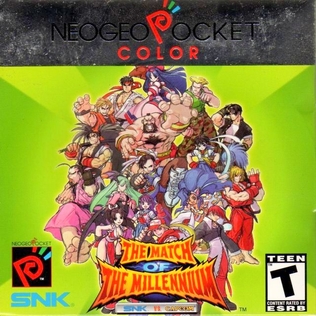
SNK vs. Capcom: The Match of the Millennium is a crossover fighting game developed and published by SNK for the Neo Geo Pocket Color in 1999.

Money Puzzle Exchanger is a puzzle game created on January 17, 1997 by Japanese video game developer Face for the Neo Geo MVS arcade system. Athena Co. Ltd. ported it to the Game Boy on August 29, 1997, and the PlayStation on November 5, 1998. The Japanese PlayStation version was made available by MonkeyPaw Games on the PlayStation Network's import store on November 16, 2010. It was later re-released as part of the Arcade Archives Neo Geo series for PlayStation 4, Xbox One and Nintendo Switch on June 28, 2018.

Super Baseball 2020 is a futuristic baseball video game. It was first released in Japan for the Neo Geo in 1991, and then it was later released in North America for the Sega Genesis and Super Nintendo Entertainment System in 1993. The North American Genesis and European Mega Drive versions feature a package illustration by Electronic Arts artist Marc Ericksen.
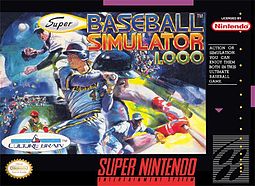
Super Baseball Simulator 1.000 is a 1991 traditional baseball simulation video game by Culture Brain for the Super NES that is the sequel to the NES game Baseball Simulator 1.000. This game is called Super Ultra Baseball (スーパーウルトラベースボール) in Japan.

Baseball Stars Professional is a baseball arcade video game developed and originally published by SNK on 26 April 1990. A follow-up to the original Baseball Stars on Nintendo Entertainment System, it was one of the launch titles for both the Neo Geo MVS (arcade) and Neo Geo AES (home) platforms, in addition of also being one of the pack-in games for the AES, as well as the first baseball title released for the Neo Geo.
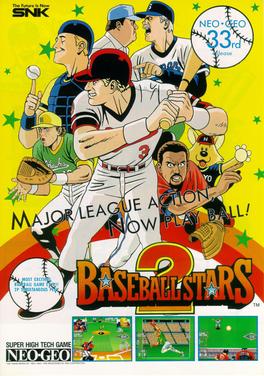
Baseball Stars 2 is a 2-player baseball sports arcade game released by SNK in 1992 for the Neo-Geo console. A less detailed console version was released for the NES by Romstar the same year.
ADK Corporation, formerly known as Alpha Denshi Corporation (アルファ電子株式会社), was a Japanese video game developer founded in 1980. ADK began as a developer of arcade games and is best known for their library of SNK Neo Geo titles, including for its home consoles, produced in partnership with SNK. Most notable among these are their fighting games and, in particular, the World Heroes series and Aggressors of Dark Kombat. The company closed with properties sold to SNK Playmore in 2003.

Major League Baseball is a sports video game released in 1988 for the Nintendo Entertainment System. It is notable for being one of the first video games licensed by Major League Baseball, although it was not endorsed by the Major League Baseball Players Association. Without the backing of the Players Association, the game could not name the actual players, although it was able to use their numbers, thus accurately portraying the contemporary teams and their rosters. In doing so, it became the first baseball game for the Nintendo Entertainment System to carry official Major League Baseball licensing and lineups.
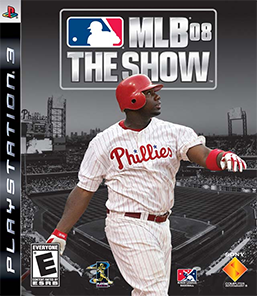
MLB 08: The Show is a baseball simulation video game developed by San Diego Studio published by Sony Computer Entertainment for the PlayStation 2, PlayStation 3, and PlayStation Portable systems. It is the longest-running officially licensed Major League Baseball game series on the PlayStation systems. MLB 08: The Show is the third edition of the MLB: The Show series of video games. The game was announced for all three PlayStation consoles on December 11, 2007, and released on March 4, 2008 in North America. Ryan Howard, all-star first baseman for the Philadelphia Phillies, is featured as the game's cover athlete.
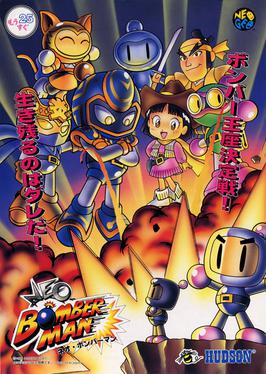
Neo Bomberman is an action-maze arcade video game developed by Produce! and published by Hudson Soft for the Neo Geo MVS on May 1, 1997. It is one of two games in the Bomberman franchise that was released for the Neo Geo platform, the first being Panic Bomber, and the only one to retain its traditional top-down gameplay. It was released for the Neo Geo MVS (arcade) and has not received a home console release to date. It was the last original Bomberman title to be released for arcades until Konami's Bombergirl in 2018.

Samurai Shodown, known in Japan as Samurai Spirits, is a fighting game developed and published by SNK for the Neo Geo arcade and home platform. Released in 1993, it is the first installment in the Samurai Shodown series. In contrast to other fighting games at the time, which were set in modern times and focused primarily on hand-to-hand combat, Samurai Shodown is set in feudal-era Japan and was SNK's first arcade fighting game to focus primarily on weapon-based combat.

Nolan Ryan's Baseball is a baseball video game endorsed by then-Texas Rangers baseball player Nolan Ryan; one of the most popular baseball players of the late 20th century. It has no licensing from Major League Baseball and the Major League Baseball Players Association; meaning that Nolan Ryan is the only non-fictional ballplayer in the entire game. All the other players have names that appear to be given names while Nolan Ryan uses his surname.

Little League Baseball: Championship Series is a 1990 video game for the Nintendo Entertainment System.

Power Spikes II is a volleyball arcade video game developed by Video System and originally published by Taito on October 19, 1994. A follow-up to Hyper V-Ball on Super Nintendo Entertainment System, it was first launched for Neo Geo MVS (arcade) and later ported to Neo Geo CD. It is the final installment in the Super Volleyball series. It is also the only volleyball game released on the Neo Geo.



















